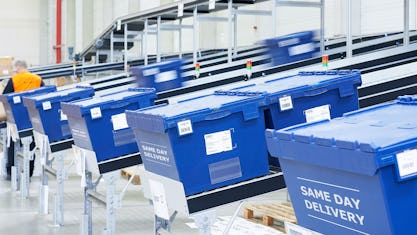
What is dropshipping?
Dropshipping has many advantages over conventional e-commerce delivery methods. It is particularly suitable for start-ups, as products are only purchased from the supplier once they have been ordered, making the business more easily scalable.
Dropshipping is an e-commerce business model in which the online retailer sells goods that it does not have in stock. After the customer has made a purchase in their online shop, the retailer orders the goods from a wholesaler or manufacturer, who then ships them directly to the customer. The dropshipper therefore has no physical contact with the product and does not maintain a warehouse. In principle, dropshipping is a logistics service provided by the wholesaler or manufacturer, and in the best-case scenario the wholesaler or manufacturer is not even visible, as the delivered goods and paperwork bear the logo and sender address of the online shop. In other words, the customer has the impression that the goods have been dispatched by the online shop itself. The dropshipping model has a number of advantages, especially for entrepreneurs who are just starting out in e-commerce. Whichever model is chosen, communication and trust in the supplier must be right, because the supplier is responsible for product quality, despatch and much more. The exchange of data between suppliers and a dropshipper on stock quantities, price changes, new products, delivery times and delivery tracking must be as transparent as possible. If appropriate, there are automated solutions for dropshipping data exchange via pre-programmed apps such as Oberlo.
What types of dropshipping are there?
In dropshipping, a basic distinction is made between fulfilment through a wholesale warehouse or a consignment warehouse. In the first example, the drop shipper potentially has access to the wholesaler's entire product range, but is limited by the wholesaler’s stock availabiliy. In the second option, the wholesaler sets up a separate storage area for the online retailer in its central warehouse and the stocks are held exclusively for him. This approach is often associated with additional costs or certain purchase obligations, however, the retailer benefits from a secure supply of goods.
Advantages of dropshipping
A major advantage of dropshipping is the low start up investment required for the physical components of a business. Warehouse premises or staff are not required and it isn’t necessary to invest in stock before orders have been received. Start up costs are incurred, for example, for the domain name, website hosting, site programming and for any ready-made e-commerce shop solutions such as Ecwid, Shopify, Magento or WooCommerce. In addition, labour costs for marketing activity such as website design, logo and SEO, must of course be budgeted for. However, these costs would also be incurred with other e-commerce models. Due to the advantages described above, the dropshipping business also enables a large product range from many different manufacturers or retailers. Products can also be easily tested for the market using advertising on Google Shopping, Facebook or Instagram, for example. Ultimately, the model, with good digital marketing, is very scalable and offers relatively good growth opportunities in a short period of time.
Disadvantages of the dropshipping model
One of the biggest advantages of dropshipping is also one of its biggest disadvantages. The dropshipping retailer does not see the goods beling sold and has no control over their dispatch. Even if the dropshipper has ordered a test product in order to check the product beforehand, they naturally do not know the quality of each shipped product in detail. Goods can be lost or damaged, which requires replacement items to be sent, meaning customer satisfaction can drop significantly. The long delivery times of retailers from Asia can also be a problem. There are certainly enough dropshipping suppliers selling from within Europe who achieve better quality, delivery times and customer satisfaction, but with the disadvantage of usually offering a lower profit margin. It needs to be understood that a significant proportion of the costs of selling products online is advertising. In order to generate any profit at all, the online shop must therefore be continually optimised to a high level. For example, strategies should be adopted to encourage the average order value of the products purchased by the customer to be as high as possible.
Be aware of the pitfalls
There are tactics designed to increase the average order value (AOV) of a webshop. Examples include bundling products into offers, volume discounts, upselling (selling a more expensive product or upgrade) and cross-selling related or complementary products. Depending on where products are sourced, dropshippers can expect extremely high competition, as many retailers sell the same products from the same source. One way out of this predicament is to invest time and money in branding the products in line with the webshop brand, but this can be expensive. Unless you are offering a store-wide "free shipping", the shipping costs add up for the customer, as the products usually have to be shipped from different retailers. Customer dissatisfaction with exorbitant shipping costs can increase very quickly and the risk of losing the customer is very high - especially if the products are of poor quality and have long delivery times. Here, finding new and innovative dropshipping solutions regarding the quality and originality of goods or their shipping times can be the important deciding success factor. Returns are very common, particularly in the online business and their management presents a logistical challenge. The returns rate is heavily product dependent,for example, according to the EHI Retail Institute, the rate in Germany for textiles and accessories reaches more than 50% for some retailers. Returns management is a major challenge for dropshipping webshops in particular, as they do not ship the goods themselves. Therefore, they have to receive the returned products at a collection address and send them back to the manufacturer or wholesaler from there in order to be reimbursed for their costs. However, many dropshippers do not have a physical address and would have to commission a provider to provide this service.
How dropshipping is changing the e-commerce landscape
Many large online retailers such as Amazon and Zappos started out with drop shipping. Other examples of successful drop shippers in the billion euro range are Wayfair and Blinds.com in the million euro range. One of the great advantages of the model is that the entrepreneur can (and should) concentrate on marketing and sales. In addition, sourcing products directly from producers in almost any quantity is easy and can be automated. There is therefore no need for a cost-prohibitive warehouse. Drop shipping is definitely not dead - quite the opposite! If the prospective entrepreneur can solve the aforementioned challenges of the business model, particularly in terms of quality, delivery times and trustworthiness, it is an ingenious and fast way to enter e-commerce. The coming years are therefore likely to see an increase in drop shipping. In general, simple and fast sourcing allows products to be tested on marketing channels quickly, almost at breakneck speed, and enables very fast entry to market. For this reason, product cycles are accelerated and winners are recognised more quickly, but also die more quickly. Drop shipping will also accelerate the automation of all processes. Even the search for winning products, which accounts for a large proportion of drop shipping, will be automated by using web scraping software.

